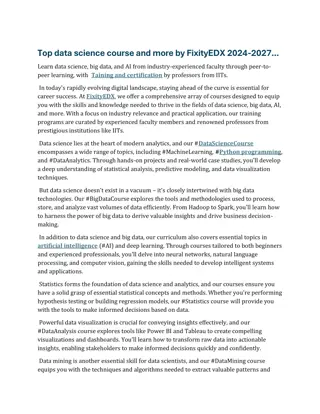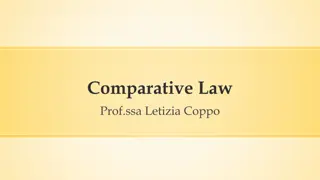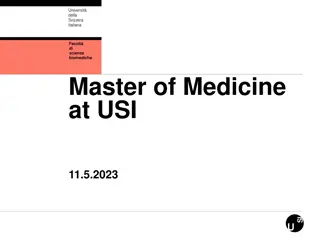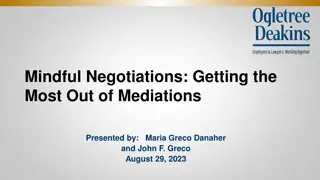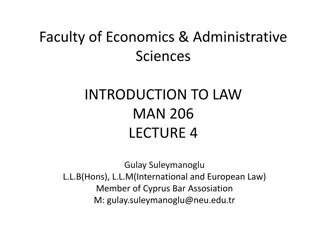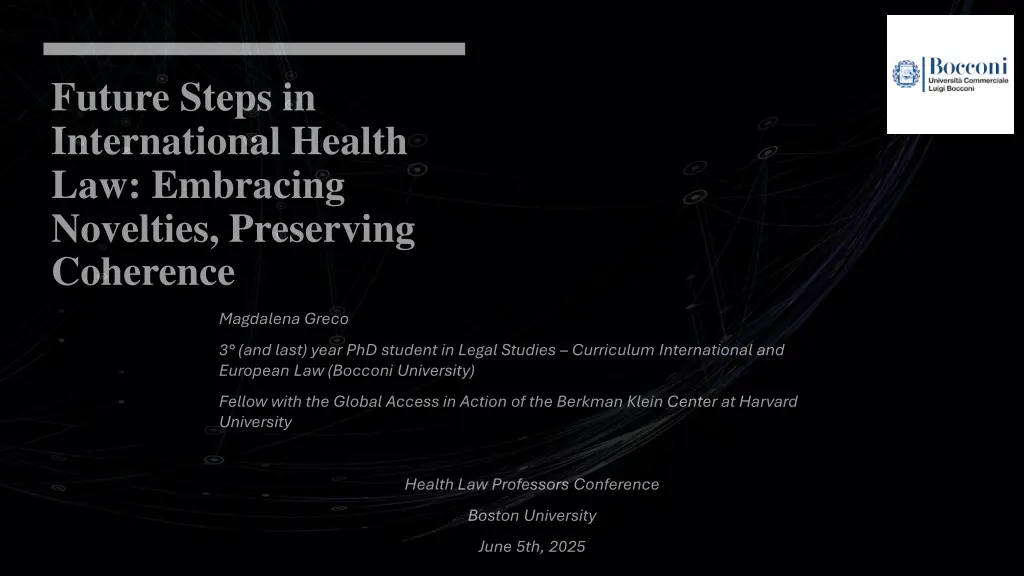
Navigating Fragmentation in International Health Law
Explore the challenges of fragmentation in global health law and its implications on international legal frameworks, focusing on the impact of the Pandemic Agreement. Magdalena Greco delves into research questions regarding the cohesiveness of global health law and the role of the World Health Organization in maintaining uniformity. Discover insights on the state of global health law post-WHA78 and the future trajectory post-Pandemic Agreement.
Download Presentation

Please find below an Image/Link to download the presentation.
The content on the website is provided AS IS for your information and personal use only. It may not be sold, licensed, or shared on other websites without obtaining consent from the author. If you encounter any issues during the download, it is possible that the publisher has removed the file from their server.
You are allowed to download the files provided on this website for personal or commercial use, subject to the condition that they are used lawfully. All files are the property of their respective owners.
The content on the website is provided AS IS for your information and personal use only. It may not be sold, licensed, or shared on other websites without obtaining consent from the author.
E N D
Presentation Transcript
Future Steps in International Health Law: Embracing Novelties, Preserving Coherence Magdalena Greco 3 (and last) year PhD student in Legal Studies Curriculum International and European Law (Bocconi University) Fellow with the Global Access in Action of the Berkman Klein Center at Harvard University Health Law Professors Conference Boston University June 5th, 2025
Structure of the presentation: Introductory remarks (research question-s); Preliminary remarks: Fragmentationof International Law; Fragmentationof Global Health Law; The Uniformity-Making Function of the World Health Organization (WHO); Transitionary remarks; The state of the art after WHA78; Article 24 of the Pandemic Agreement; The way forward.
Introductory Remarks (Research Questions) How will the Pandemic Agreement impact on the already widely fragmented framework of international law in general, and global health law in particular? How is fragmentation dealt with in the Pandemic Agreement? What will the relations be between the Pandemic Agreement and other international instruments both in global health law and beyond? How are those relations regulated within the Agreement?
A curiosity This issue has often been left on the margins of the INB debate. Why? Other topics (e.g. equity, PABS) were more urgent and politically sensitive? Unknown reason.
Preliminary remarks (1) The Fragmentation of International Law 2006 Seminal report of the International Law Commission(ILC): Increase in scope of international law; Language of diplomats trade, human rights, scientific and technological cooperation
Preliminary Remarks (2): Fragmentation of Global Health Law Trade, human rights, scientific and technological cooperation Fragmented patchwork of binding and non-binding legal instruments that impacted on the regulation of global health Global health law = A set of legal frameworks that structure global health
Preliminary Remarks (3): The Uniformity-Making Function of the WHO However, global health law, if analyzed under the mere perspective of the quantitavely poor normative production of the WHO = partially a step towards the de-fragmentation (= unification) of the first health-centered negotiating efforts made by the international community.
Preliminary Remarks (3): The Uniformity-Making Function of the WHO WHO constitutional mandate to negotiate treaties, regulations or recommendations with respect to any matter within the competence of the Organization (articles 19, 21 and 23 of the WHO Constitution) WHO = coherency/uniformity-making institution aimed at bringing together ratione materiae any negotiating effort aimed at driving the global population towards the highest possible level of health.
Transitionary Remarks: Idea of a Framework Convention on Global Health (FCGH) capable of bringing clarity and precision to norms and standards surrounding the right to health (Gostin et al.); UN Secretary General Ban Ki-moon supported the creation of such an instrument, and he called to set the stage for a future United Nations framework convention on global health .
INB under its PPPR-centered mandate tried to find the perfect formula to unify the fragmented elements of global health law within a fragmented international law scenario, while upholding the WHO core vision of cohesion in global health governance. Combining, and not dividing.
Does the Pandemic Agreement under the unifying mandate of WHO law materialize the ambitions of a clarity-and-precision-led FCGH? How will it be positioned and what consequences will its adoption have on the fragmented international and global health law scenario?
The state of the art after WHA78 Many provisions of the last draft of the Pandemic Agreement (at least in articles 4, 11, 12) directly interact with at least five internationally binding and non-binding agreements: The United Nations Convention on Biological Diversity (CBD); The Nagoya Protocol on Access to Genetic Resources; The IHR (2005); The Pandemic Influenza Preparedness (PIP) Framework; The World Trade Organization (WTO) Agreement on Trade-Related Aspects of Intellectual Property Rights (TRIPS).
First (February 2023) did not contain any conflict clause devoted to regulating the interaction between the Pandemic international instruments; draft of the Pandemic Agreement Agreement and other Only April, May 2023 drafts). later on the issue appeared (March,
Article 24 after WHA78 (1) The interpretation and application of the WHO Pandemic Agreement shall be guided by the Charter of the United Nations and the Constitution of the World Health Organization;
(2) The Parties recognize that the WHO Pandemic Agreement and the International Health Regulations (2005) and other relevant international agreements should be interpreted so as to be compatible;
(3) The provisions of the WHO Pandemic Agreement shall not affect the rights and obligations of any Party deriving from other international instruments. agreements and legal
The new text (greened after INB/13 (art. 26) and WHA78) reflects what it seems to be a slight shift from the November version; The latter specified that [t]he provisions of the WHO Pandemic Agreement shall not affect the rights and obligations of any Party under other existing legally binding international instruments to which it is a Party, provided that the exercise of those rights and obligations is compatible with the objective of this instrument ; In the latest version of the article, the reference to compatibility with the objective of the Pandemic Agreement has been replaced with a more general compatibility and non-affection clause between the Agreement and other international agreements and legal instruments.
The multidisciplinary nature of the Pandemic Agreement has the potential of being a clear example of simultaneous validity of two (or more) norms where each covers the facts of which the situation consists , to quote the ILC report.
The INB seems to have moved from an approach centered on the relationship of conflict, according to which when two norms that are both valid and applicable point to incompatible decisions, [ ] a choice must be made between them , to a different perspective
This presumption arguably hints to the relationship of interpretation, where one norm assists in the interpretation of another [ ] in such a way that both norms are applied in conjunction . On the other, the same presumption appears to point at the principle of harmonization, according to which when several norms bear on a single issue, they should, to the extent possible, be interpreted so as to give rise to a single set of compatible obligations .
The way forward The WHO has given attention to the relationship between the Pandemic Agreement and the IHR, the Pandemic Agreement and its Annexes and Protocols, and to inter alia the CBD during the so-called interactive dialogues . However it is now necessary to have a consistent debate on the impact of the new agreement on other confining internationalagreements and legal instruments .
The sand in the hourglass of the INB process has elapsed, and negotiators tried to come up with a forward-looking conflict clause, that ought to be as clear and specific as possible. The aim is to have a clause capable of building a sustainable and coherent PPPR framework that, guided by the uniformity-lead normative powers of the WHO, will contribute to ease the international (global health) legal framework, and not to further complicate it.
Is the final conflict clause satisfactory? Are: The relationship of interpretation; The principle of harmonization; The presumption of compatibility The way forward?
Eg. Art. 17.3: The Parties shall collaborate and cooperate for PPPR through strenghtening and enhancing cooperation among relevant legal instruments and frameworks [ ] in the achievement of the objective of the WHO Pandemic Agreement, while closely coordinating supporting with that provided under the IHR (2005) ; Eg. Art. 12 (d) (i): Complementarity to and not duplicative of access and benefit sharing measures and obligations contained in PIP and other relevant international access and benefit sharing instruments where applicable ; Art. 12(d)(ii): To ensure that each Party reviews and, as it deems appropriate, aligns its national and/or regional ABS measures applicable to PABS materials and Sequence Information within the scope of the PABS Instrument, so that measures that are contrary to, or inconsistent with, or duplicative of, the PABS instrument will not be applied upon entry into operation of all the elements of PABS ; Art. 12(e): Implementation consistent with applicable international law and with applicable national/Domestic law, regulations and standards related to risk assessment, biosafety, biosecurity and expotr control of pathogens and data protection .
The very effort to canvass a coherent legal-professional technique on a fragmented world expresses the conviction that conflicts between specialized regimes may be overcome by law, even as the law may not go much further than require a willingness to listen to others, take their point of view into account and to find a reasoned resolution at the end. Yet this may simply express the very point for which international law has always existed [ILC 2006 Report, cit.]
Thank you for your attention! magdalena.greco@phd.unibocconi.it References: Magdalena Greco, On the Fragmentation of International Law and Global Health Law: A Comment before the Round of the Agreement, V lkerrechtsblog, doi: 10.17176/20250410-011803-0. INB/13 WHO Negotiating Pandemic 09.04.2025,



